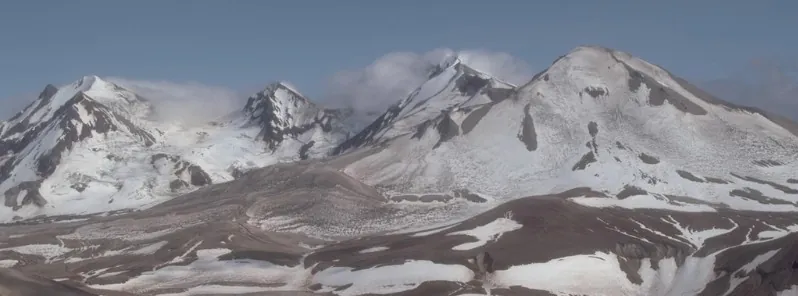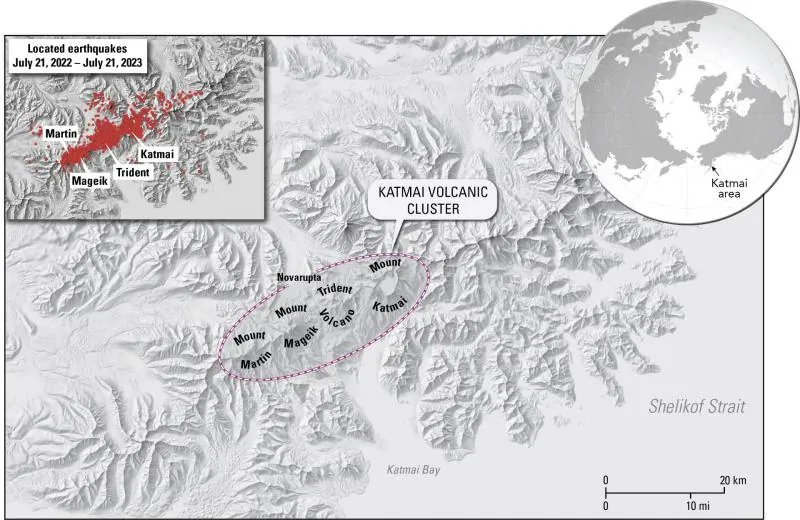Magma intrusion at Trident volcano, site of the world’s largest eruption of 20th century, Alaska

Alaska’s Trident volcano has seen a significant increase in seismic activity and ground uplift over the past five months, leading to concerns about a potential volcanic eruption. The Alaska Volcano Observatory (AVO) has confirmed that this unrest is the result of magma intrusion beneath the volcano. The rising magma, which can trigger an eruption, has also caused increased seismic activity in the neighboring volcanoes of the Katmai volcanic cluster, including Katmai, Martin, Mageik, and the Novarupta vent.
- The world’s largest eruption of the 20th century occurred in June 1912 near the base of the Trident volcano.
The unrest started in August 2022, with an unusual series of earthquakes migrating progressively from depths of about 25 km (16 miles) below sea level to shallower depths of approximately 5 km (3 miles). The earthquake activity has fluctuated since then, prompting the AVO to alternately raise and lower the Volcano Alert Level and Aviation Color Code. By February 2023, the persistent seismicity led the AVO to upgrade the Alert Level to ADVISORY and the Aviation Color Code to YELLOW.
From May 2023, the AVO detected a marked increase in low-frequency earthquakes in the region between Trident and Novarupta, often indicative of magma or magmatic fluid movement within the Earth’s crust. Concurrently, satellite data indicated ground uplift at Trident Volcano, with an estimated uplift of about 5 cm (2 inches) since October 2022, particularly on the volcano’s south flank.

Although the current signs point towards magma moving upwards, it is important to note that such activity doesn’t always result in an eruption. Sometimes the seismic activity and ground uplift can cease without an eruption, or the unrest could persist for months or years before an eruption occurs. The type of unrest typically observed before eruptive activity would allow the AVO to provide advance warning. This includes changes in ground uplift pattern, increased earthquake activity, increased ground surface temperatures, and possible gas emissions.
If an eruption occurs, the primary hazards would be volcanic ashfall and drifting ash clouds, which could disrupt air and marine travel and impact local communities and infrastructure. The areas impacted would largely depend on the wind direction during the eruption. Closer to the eruption site, additional hazards such as ballistics or pyroclastic flows could occur.
The last eruption (VEI 3) of this volcano started on July 15, 1974, and lasted about 45 days.
The largest eruption of the 20th century occurred in June 1912 near the base of the Trident volcano. The eruption occurred at a location known as Novarupta, close to a group of late Quaternary stratocones and domes that have released an estimated 140 km3 (33.6 mi3) of magma over the past 150 000 years. Despite the eruption occurring closest to the Trident volcano group and other nearby volcanoes, it was Mount Katmai, 10 km (6.2 miles) east of Novarupta, that experienced a significant collapse, forming a 5.5 km3 (1.3 mi3) caldera.
The eruption was accompanied by many earthquakes, including 14 ranging from magnitude 6 to 7, which released 250 times more seismic energy than the 1991 caldera-forming eruption of the Pinatubo volcano in the Philippines.
Around 13 km3 (3.1 mi3) of magma erupted in 1912, which included a significant amount of high-silica rhyolite and crystal-rich dacite. The Katmai caldera only compensated for 40% of the erupted magma.
References:
1 ALASKA VOLCANO OBSERVATORY INFORMATION STATEMENT – U.S. Geological Survey – Tuesday, July 25, 2023, 17:22 UTC
2 Katmai volcanic cluster and the great eruption of 1912 – USGS – Accessed July 25, 2023
Featured image: Trident, seen here from Baked Mountain to its NW, was initially named for its three prominent summits. A series of eruptions from 1953 until 1968 constructed a fourth cone, which forms the smoother peak to the right. As many as 23 lava domes are found in the Trident volcanic complex. The 1912 Novarupta lava dome is visible to the lower center. Photo by Game McGimsey (U.S. Geological Survey, Alaska Volcano Observatory).

Commenting rules and guidelines
We value the thoughts and opinions of our readers and welcome healthy discussions on our website. In order to maintain a respectful and positive community, we ask that all commenters follow these rules.